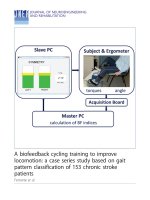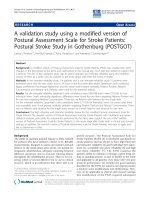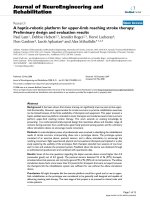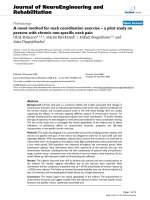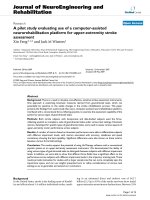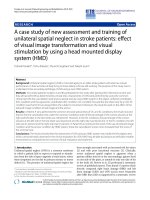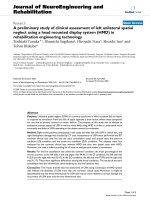báo cáo hóa học:" A genetic association study between growth differentiation factor 5 (GDF 5) polymorphism and knee osteoarthritis in Thai population" ppt
Bạn đang xem bản rút gọn của tài liệu. Xem và tải ngay bản đầy đủ của tài liệu tại đây (447.26 KB, 5 trang )
RESEARCH ARTICLE Open Access
A genetic association study between growth
differentiation factor 5 (GDF 5) polymorphism
and knee osteoarthritis in Thai population
Tulyapruek Tawonsawatruk
1*
, Theeraroj Changthong
1
, Sarinee Pingsuthiwong
2
, Objoon Trachoo
2
,
Thanyachai Sura
2
and Wiwat Wajanavisit
1
Abstract
Objective: Osteoarthritis (OA) is a multi-factorial disease and genetic factor is one of the important etiologic risk
factors. Various genetic polymorphisms have been elucidated that they might be associated with OA. Recently,
several studies have shown an association between Growth Differentiation Factor 5(GDF5) polymorphism and knee
OA. However, the role of genetic predisposing factor in each ethnic group cannot be replicated to all, with
conflicting data in the literatures. Therefore, the aim of this study was to investigate the association between GDF5
polymorphism and knee OA in Thai population.
Materials and Methods: One hundred and ninety three patients aged 54-88 years who attended Ramathibodi
Hospital were enrolled. Ninety cases with knee OA according to American College of Rheumatology criteria and
one hundred and three cases in control group gave informed consent. Blood sample (5 ml) were collected for
identification of GDF5 (rs143383) single nucleotide polymorphism by PCR/RFLP according to a standard protocol.
This study protocol was approved by the Ethics Committee on human experimentation of Ramathibodi Hospital
Faculty of Medicine, Mahidol University. Odds ra tios (OR) and 95% confidence intervals were calculated for the risk
of knee OA by genotype (TT, TC and CC) and allele (T/C) analyses.
Results: The baseline characteristics between two groups including job, smoking and activity were not different,
except age and BMI. The entire cases and controls were in Hardy-Weinberg equilibrium (p > 0.05). The OA knee group
(n = 90) had genotypic figure which has shown by TT 42.2% (n = 38), TC 45.6% (n = 41) and CC 12% (n = 11), whereas
the control group (n = 103) revealed TT 32% (n = 33), TC 45.6% (n = 47), and CC 22.3% (n = 23), respectively. Genotypic
TT increased risk of knee OA as compared to CC [OR = 2.41 (P = 0.04, 95%CI = 1.02-5.67)]. In the allele analysis, the T
allele was found to be significantly associated with knee OA [OR = 1.53 (P = 0.043, 95%CI = 1.01-2.30)].
Conclusion: These data suggested that GDF5 polym orphism has an association with knee OA in Thai ethnic. This
finding also supports the hypothesis that OA has an important genetic component in its etiology, and GDF5
protein might play important role in the pathophysiology of the disease.
Keywords: Osteoarthritis, Growth Differentiation Factor 5, GDF5, SNP, RFLP, Thais
Introduction
It is widely believed that osteoarthritis develops from an
imbalance between anabolic and catabolic processes or
homeostasis of cartilage metabolism [1,2]. The etiology
of this disease is related to genetic association [3].
Recently, several studies have demonstrated the poly-
morphism in many genes which might be related to the
pathogenesis of osteoarthritis [4-14]. Growth Differentia-
tion Factor 5 or GDF5 gene regulates the expression of
the GDF5 protein which is closely related to BMP and
is a mem ber of TGF-beta superfamily [15]. It has a role
in regulation of the chondrogenesis and the defect in
this gene might be correlated to the abnormal joint
development [15]. It has been reported in animal study
* Correspondence:
1
Department of Orthopedics, Faculty of Medicine, Ramathibodi Hospital,
Mahidol University, Bangkok 10400, Thailand
Full list of author information is available at the end of the article
Tawonsawatruk et al. Journal of Orthopaedic Surgery and Research 2011, 6:47
/>© 2011 Tawonsawatruk et al; licensee BioMed Central Ltd. This is an Open Access article distributed under the ter ms of the Creative
Commons Attribution License ( which permits unrestricted use, distribution, and
reproduction in any medium, provided the original work is properly cited.
that GDF5 knockout mice develops knee joint anoma ly
[16]. Moreover, it has been shown that he polymorph-
ism in GDF5 gene is related with low expression of the
GDF5 protein in knee joint [17].
The large scale analysis has shown that the association
of this polymorphism (rs143383) in promoter area
might be a risk factor of the osteoarthritis [18]. In addi-
tion, studies of this genetic variant in China and Japan
have shown the association of T allele and knee OA
[19]. However, there is a report from Greece which had
an inconsistent result and found no an association [20].
The genetic susceptibility of the disease in different eth-
niccannotbeappliedtoothersbecauseeachethnichas
adifferentgeneticbackground.Thereisagapofinfor-
mation about this polymorphism in Thai population,
therefore the objective of this study is to determine t he
association of the SNP rs143383 in GDF5gene and knee
OA in Thai population.
Patients and Methods
Subjects
Our study was approved by the Ethics Committee of the
Faculty of Medicine, Ramathibodi Hospital, Mahidol
University, Bangkok, Thailand. All patients recruited in
the study were Thai by nationality and had ancestors
settled in Thailand for at least three generations. In
total, 90 patients with knee OA who underwent total
knee arthroplasty (TKA) and 103 patients without knee
OA were enrolled from Department of Orthopedics,
Ramathibodi Hospital. Informed consent was performed
after the purpose of the research project and it had
been clearly explained to the patients. The diagnosis of
knee OA was based on the American College of Rheu-
matology criteria [21]. Both OA and control groups
were int erviewed to obtain demographic data and all o f
established risk factors. Th ereafter, standard weight-
bearing antero-posterior and lateral view of knee radio-
graphs were taken to confirm the diagnosis of OA by
Kellgren and Lawrence scores (KL scores) [22].
Laboratory technique
PCR-RFLP for BsiEI restriction site was used for SNP in GDF-
5 identification
Firstly, 5 ml peripheral blood sample was collected from
patient using ethylenediamine tetraacetic acid as an
anticoagulant and processed for SNP analysis. Genomic
DNA was extracted from buffy coat leukocytes using the
standard phenol-chloroform method. PCR primers to
amplify the promoter area of GDF5 gene were designed
by the Primer-3 web-based tool [23]: GATTTTTTCT-
GAGCACCTGCAGG (forward) and GTGTGTGTT
TGTATCCAG (reverse). 50 μlPCRmixturecontained
100 ng of genomic DNA, 20 pmol of each primer, 0.2 μ
M of each dNTP, 1 unit of Taq DNA polymerase
(AmpliTaq
®
, Applied Biosystem, Foster C ity, CA), 3.0
mM MgCl2 in 10 × PCR buffer containing 10 mmol of
Tri-HClpH9.0,10mmolKCland0.1%TritonX-100
(Invitrogen, Carlsbad, CA). PCR reaction was started
with an initial denaturation at 95°C for 5 min, followed
by 35 cycles of amplification in a thermocycler (PCR
Sprint, Thermofis her, Waltham, MA) with denaturation
at 94°C for 1 min, annealing at 58°C for 1 min, exten-
sion at 72°C for 1 min, and final extension at 72°C for
10 min. Then, 10 μL of PCR product was incubated at
37°C with 3 units of BsiEI for 4 hours under the manu-
factur er ’ s recommended conditions (New England Bio-
labs, Ipswich, MA). The digested product was
electrophoresed on 2% agarose gel with ethidium bro-
mide staining before being visualize d on a UV tr ansillu-
minator (Figure 1). The expected fragment length was
104 and 230 bp in CC, 104, 230, and 344 bp in TC, and
344 bp in TT genotypes, respectively.
Statistical analyses
Analysis of demographic data was performed by Excel
2007 (Microsoft
®
Excel
®
). The unpaired t-test was used
for continuous data and Chi-square was used for catego-
rical data. Allele frequencies, Odds ratio and the prob-
ability f or Hardy-Weinberg Equilibrium were estimated
and analyzed as explained by following website; http://
ihg.gsf.de/cgi-bin/hw/hwa1.pl.
Results
In our study, the average age of patients in the knee OA
group was significant o lder than in the control. BMI
which is one of the risk factor of knee OA was also
slightly higher in the OA patient group. However, other
Figure 1 shows the bands of each genotype in the
electrophoresis gel: A represents TT, B represents CC and C
represents TC.
Tawonsawatruk et al. Journal of Orthopaedic Surgery and Research 2011, 6:47
/>Page 2 of 5
possible risk factors which might be related to OA as
well as patient life style were comparable between these
two g roups. The baseline characteristics of the patients
are shown in Table 1. The prevalence of allele T and C
in o ur sample was normally distributed according to the
Hardy-Weinberg Equilibrium (p-value < 0.05). The com-
parison of the number and odd ratio o f genotype TT,
TC, TT+TC with CC o f GDF5 polymorphism
(rs143383) in the promoter area between case and con-
trol is demonstrated in Table 2 . When analyzing by
allele (shown in table 3), the odds ratio of T allele was
1.53 (95%C.I. = 1.01-2.31), which delineated the increase
in risk to develop knee OA. Our result shown that this
polymorphism, T/C, is inherited by autosomal recessive
manner as the TT genotype increases risk of the disea se
significantly (OR = 2.41, 95%C.I. = 1.02-5.67), whereas
the TC has no significant difference.
Discussion and Conclusion
Our study has shown the statistically sig nificant associa-
tion b etween polymorphism in promoter of GDF5 gene
(rs143383) and knee osteoarthritis in Thai population.
We found that T allele in GDF5 polymorphism was a
significant risk factor for knee osteoarthritis with Odds
ratio 1.53 (95%C.I. = 1.01-2.31). When analyse d by gen-
otype, it w as found that the TT genotype increased risk
of knee OA, whereas TC has not shown any correlation.
Regarding these finding, it suggests that this poly-
morphic gene might be expressed as the autosomal
recessive type. The GDF5 gene is located on the chro-
mosome 20q11.2 and it regulates the expression of
GDF5 protein. It is categorised in the class of bone mor-
phogenetic protein (BMP) [15]. It involves in develop-
ment of bone and cartilage, particularly in endochondral
ossification process [24,25]. The mutation of GDF5
associates with generalised osteoarthritis and skeletal-
related congenital diseases. Acromesomelic chondrodys-
plasia; Grebe type and Hunter-Thompson type is
autosomal recessive form which is rare heredita ry skele-
tal disorders. They are presented by short s tatus, abnor-
mal limbs development. Brachydactyly type A1, A2 and
C and symphalangism proximal syndrome are inherited
malformation presented with abnormal morphology of
hand and finger. Multiple synostoses syndrome type 2 is
an autosomal dominant condition characterised by pro-
gressive joint fusions and progre ssive conductive deaf -
ness. Du Pan syndrome is a rare autosomal recessive;
the patient presents with absence of the fibulae and
severe acromesomelic lim b shortening with small, non-
functional toes. These abnormal conditions have been
reported that they have a mutation in GDF5 gene, thus
they support that GDF5 plays a role in skeletal develop-
ment [26,27]. Recently, it has been reported that GDF5
deficiency mice had the delay fracture healing process
that impaired the cartilaginous matrix deposition in the
callus and reduced callus cross-sectional area [28].
The functional study o f this polymorphism has been
demonstrated; T allele in rs143383 was associated with
thedecreaseofGFD5 molecule expression and might
increase susceptibility to osteoarthritis [17]. Moreover, it
has been report that the differential binding of deformed
epidermal autoregulatory factor 1 (DEAF-1) can modu-
late the expre ssion of GDF5 v ia this polymorphism [29].
It is believed that GDF5 plays role in the regulation of
the chondrogenic cell growt h and differentiation. These
evidences support the function of GDF5 gene which
might indicate the importance of this polymorphism in
osteoarthritis etiology. As the result, many scientists
have been working for study the association of this poly-
morphism in GDF5 gene. Recently, a large scale associa-
tion study between GDF5 gene and osteoarthritis has
revealed the genetic susceptibility of polymorphism in
Table 1 Shows the base line characteristics between
cases and controls
Variables Cases
(n = 103)
Control
(n = 103)
p-value
Age (years), mean (SD) 68.46(10.0) 59.25(9.0) < 0.01*
Onset of disease (years), mean (SD) 61.46(9.06) N/A N/A
Female (%) 79(87.25) 93(90.29) 0.7
BMI (kg/m
2
), mean (SD) 26.66(4.0) 24.57(5.0) < 0.01*
History of labor work (%) 25(27.78) 30(29.13) 0.20
Regular exercise (%) 10(11.11) 13(12.62) 0.15
Kneeling activity (%) 37(41.11) 48(46.60) 0.07
Previous any fracture (%) 9(10.0) 13(12.62) 0.15
Smoking (%) 2(2.22) 4(3.88) 0.10
Note: *statistically significant, SD = standard deviation, N/A = not applicable
Table 2 Shows the association between each genotype
and risk of knee OA
Genotype Case
(n = 90)
Control
(n = 103)
Odds ratio
(95%CI)
p-value
TT 38 33 2.41(1.022-5.670) 0.04*
TC 41 47 1.82(0.794-4.190) 0.15
TT + TC 79 80 2.07(0.944-4.517) 0.06
CC 11 23 1 N/A
(CC was used for calculation Odd ratio of TT, TC and TT+TC)
Notes: *statistically significant, N/A = not applicable
Table 3 Shows the association between allele and knee
OA
Allele Case Control Odds ratio (95%CI) p-value
T 117 113 1.53(1.013-2.306) 0.04*
C 63 93 1 N/A
(C was used for calculation Odd ratio of T)
Notes: *statistically significant, N/A = not applicable
Tawonsawatruk et al. Journal of Orthopaedic Surgery and Research 2011, 6:47
/>Page 3 of 5
the GDF5; rs143383 with odds ratio 1 .12 (95%CI 0.99-
1.31) [18]. This study included the data from diverse
ethnics which have been reported in the recent litera-
tures. However, the magnitude of this association is
smaller than the Asian ethnic, it has been reported from
Japan that odds ratio is 1.79 (P = 1.18 × 10-13) for
GDF5 polymorphism with per-risk allele (T) odds ratio
by Miyamoto et al [17]. The magnitude of the associa-
tion of GDF5 polymorphism is different between Cauca-
sian ethnic and Asian ethnic. Furthermore, the
association of t his polymorphism from Greek and Kor-
ean study cannot demonstrate the association of GDF5
polymorphism [20,30]. We have also report ed the poly-
morphism in ESR1, which is associated with knee OA in
Korean population. However, our result did not show
any statistically significant difference [31]. Thus, these
evidences can imply that the association of ethic and
genetic susceptibility in osteoarthritis might not be con-
sistent among the different populations and cannot be
applied to others.
In addition, there is a report that GDF5 polymorphism
(rs143383) also predisposes to Lumbar disc degeneration
in women. Lumbar disc degeneration which is defined
by disc space narrowing and the presence of osteophytes
significantly associates with GDF5 polymorph ism from
cohorts from Northern Europe in women, with an odds
ratio (OR) of 1.72 (95% CI 1.15-2.57) [32]. The genome-
wide association study from Finland and Sardinia shows
the co mmon variants in GDF5 contribute to height dif-
ference [33]. The GDF5 gene might be involved skeletal
growth and d evelopment and GDF5 variants might play
role in pathogenesis of bone and cartilage diseases.
Although the sample size in our study was small when
compared to previous studies, these limited samples
were sufficient for de monstrating the statistically signifi-
cant association of rs143383 in GDF5 core promotor
area. Furthermore, the populationinourstudywasin
homogeneity and the distribution between the case and
control groups was in the H ardy Weinberg’ s equil i-
brium. Therefore, our study can represent the significant
susceptibility of GDF5 in knee osteoarthritis in Thai eth-
nic. Our findings have emphasized this association that
the susceptibility of the polymorphism in GDF5 among
the Asian population because the magnitude of associa-
tion is close to Japan and Chinese population. It is pos-
sible that Thai population ethnic is believed to be close
to Chinese ancestry. Finally, we decide to leave some
suggestions in genetic susceptibility study. Firstly, it is
important to study the genetic susceptibili ty in common
disease as this might b e valuable fo r further investiga-
tion in order to understand the disease at molecular
level or even apply to use for disease screening. More
important, the association between polymorphism and
disease might not similar in different ethics; therefore
the genetic susceptibility from different ethics is
required and the meta-analysis should be conducted in
the adjac ent area or similar ge netic background. Lastly,
other modern technology such as microarray technique
should be employed for investigation of genetic suscept-
ibility in osteoarthritis.
Acknowledgements and Funding
This work was supported by grants from the biomedical research fund
(#50039) of Faculty of Medicine, Ramathibodi Hospital, Bangkok, Thailand.
Author details
1
Department of Orthopedics, Faculty of Medicine, Ramathibodi Hospital,
Mahidol University, Bangkok 10400, Thailand.
2
Division of Medical Genetics
and Molecular Medicine, Department of Medicine, Faculty of Medicine,
Ramathibodi Hospital, Mahidol University, Bangkok 10400, Thailand.
Authors’ contributions
TT conducted the acquisiti on, analysis and interpretation of data, carried out
the molecular genetic studies and drafted the manuscript. TC collected data.
SP carried out the genetic study; RFLP. OT participated in the design of the
study and performed the statistical analysis. TS and WW participated in its
design and coordination and helped to draft the manuscript. All authors
read and approved the final manuscript.
Competing interests
The authors declare that they have no competing interests.
Received: 27 March 2011 Accepted: 21 September 2011
Published: 21 September 2011
References
1. Felson DT: Osteoarthritis of the knee. N Engl J Med 2006, 354:841-8.
2. Sandell LJ, Aigner T: Articular cartilage and changes in arthritis. An
introduction: cell biology of osteoarthritis. Arthritis Res 2001, 3:107-13.
3. Lanyon P, Muir K, Doherty S, Doherty M: Assessment of a genetic
contribution to osteoarthritis of the hip: sibling study. BMJ 2000,
321:1179-83.
4. Loughlin J, Sinsheimer JS, Mustafa Z, Carr AJ, Clipsham K, Bloomfield VA,
Chitnavis J, Bailey A, Sykes B, Chapman : Association analysis of the
vitamin D receptor gene, the type I collagen gene COL1A1, and the
estrogen receptor gene in idiopathic osteoarthritis. J Rheumatol 2000,
27:779-84.
5. Spector TD, MacGregor AJ: Risk factors for osteoarthritis: genetics.
Osteoarthritis Cartilage 2004, 12(Suppl A):39-44.
6. Smith AJ, Keen LJ, Billingham MJ, Perry MJ, Elson CJ, Kirwan JR, Sims JE,
Doherty M, Spector TD, Bidwell JL: Extended haplotypes and linkage
disequilibrium in the IL1R1-IL1A-IL1B-IL1RN gene cluster: association
with knee osteoarthritis. Genes Immun 2004, 5:451-60.
7. Aigner T, Dudhia J: Genomics of osteoarthritis. Curr Opin Rheumatol 2003,
15:634-40.
8. Kizawa H, Kou I, Iida A, Sudo A, Miyamoto Y, Fukuda A, Mabuchi A,
Kotani A, Kawakami A, Yamamoto S, Uchida A, Nakamura K, Notoya K,
Nakamura Y, Ikegawa S: An aspartic acid repeat polymorphism in asporin
inhibits chondrogenesis and increases susceptibility to osteoarthritis. Nat
Genet 2005, 37:138-144.
9. Mabuchi A, Ikeda T, Fukuda A, Koshizuka Y, Hiraoka H, Miyoshi K, Haga N,
Kawaguchi H, Kawakami A, Yamamoto S, Takatori Y, Nakamura K, Ikegawa S:
Identification of sequence polymorphisms of the COMP (cartilage
oligomeric matrix protein) gene and association study in osteoarthrosis
of the knee and hip joints. J Hum Genet 2001, 46:456-462.
10. Mototani H, Mabuchi A, Saito S, Fujioka M, Iida A, Takatori Y, Kotani A,
Kubo T, Nakamura K, Sekine A, Murakami Y, Tsunoda T, Notoya K,
Nakamura Y, Ikegawa S: A functional single nucleotide polymorphism in
the core promoter region of CALM1 is associated with hip osteoarthritis
in Japanese. Hum Mol Genet 2005, 14:1009-1017.
11. Ikeda T, Mabuchi A, Fukuda A, Hiraoka H, Kawakami A, Yamamoto S,
Machida H, Takatori Y, Kawaguchi H, Nakamura K, Ikegawa S: Identification
Tawonsawatruk et al. Journal of Orthopaedic Surgery and Research 2011, 6:47
/>Page 4 of 5
of sequence polymorphisms in two sulfation-relatedgenes, PAPSS2 and
SLC26A2, and an association analysis with knee osteoarthritis. J Hum
Genet 2001, 46:538-543.
12. Jiang Q, Shi D, Yi L, Ikegawa S, Wang Y, Nakamura T, Qiao D, Liu C, Dai J:
Replication of the association of the aspartic acid repeat polymorphism
in the asporin gene with knee-osteoarthritis susceptibility in Han
Chinese. J Hum Genet 2006, 51:1068-1072.
13. Valdes AM, Spector TD: The contribution of genes to osteoarthritis.
Rheum Dis Clin North Am 2008, 34:581-603.
14. Valdes AM, Loughlin J, Timms KM, van Meurs JJ, Southam L, Wilson SG,
Doherty S, Lories RJ, Luyten FP, Gutin A, Abkevich V, Ge D, Hofman A,
Uitterlinden AG, Hart DJ, Zhang F, Zhai G, Egli RJ, Doherty M, Lanchbury J,
Spector TD: Genome-wide association scan identifies aprostaglandin-
endoperoxide synthase 2 variant involved in risk of knee osteoarthritis.
Am J Hum Genet 2008, 82:1231-4.
15. Buxton P, Edwards C, Archer CW, Francis-West P: Growth/differentiation
factor-5 (GDF-5) and skeletal development. J Bone Joint Surg Am 2001,
83-A(Suppl 1):23-30.
16. Harada M, Takahara M, Zhe P, Otsuji M, Iuchi Y, Takagi M, Ogino T:
Developmental failure of the intra-articular ligaments in mice with
absence of growth differentiation factor 5. Osteoarthritis Cartilage 2007,
15:468-74.
17. Miyamoto Y, Mabuchi A, Shi D, Kubo T, Takatori Y, Saito S, Fujioka M,
Sudo A, Uchida A, Yamamoto S, Ozaki K, Takigawa M, Tanaka T,
Nakamura Y, Jiang Q, Ikegawa S: A functional polymorphism in the 5’-UTR
of GDF5 is associated with susceptibility to osteoarthritis. Nat Genet 2007,
39:529-33.
18. Evangelou E, Chapman K, Meulenbelt I, et al: Large-scale analysis of
association between GDF5 (rs143383) and FRZB (rs7775 and rs288326)
variants and hip, knee and hand osteoarthritis. Arthritis Rheum 2009,
60:1710-1721.
19. Chapman K, Takahashi A, Meulenbelt I, Watson C, Rodriguez-Lopez J, Egli R,
Tsezou A, Malizos KN, Kloppenburg M, Shi D, Southam L, van der
Breggen R, Donn R, Qin J, Doherty M, Slagboom PE, Wallis G, Kamatani N,
Jiang Q, Gonzalez A, Loughlin J, Ikegawa S: A meta-analysis of European
and Asian cohorts reveals a global role of a functional SNP in the 5’UTR
of GDF5 with osteoarthritis susceptibility. Hum Mol Genet 2008,
17:1497-504.
20. Tsezou A, Satra M, Oikonomou P, Bargiotas K, Malizos KN: The growth
differentiation factor 5 (GDF5) core promoter polymorphism is not
associated with knee osteoarthritis in the Greek population. J Orthop Res
2008, 26:136-40.
21. Altman R, Asch E, Bloch D, Bole G, Borenstein D, Brandt K, Christry W,
Cooke TD, Greenwald R, Hochberg M, Howell D, Kaplan W, Koopman T,
Meenan R, Mqskowitz R, Murphy W, Rothschild B, Segal M, Sokoloff L,
Wolfe F: Development of criteria for the classification and reporting of
osteoarthritis: classification of osteoarthritis of the knee. Diagnostic and
Therapeutic Criteria Committee of the American Rheumatism
Association. Arthritis Rheum 1986, 29:1039-49.
22. Kellgren JK, Lawrence JS: Radiological assessment of osteoarthritis. Ann
Rheum Dis 1957, 16:494-501.
23. Rozen S, Skaletsky HJ: Primer3 on the WWW for general users and for
biologist programmers. In
Bioinformatics Methods and Protocols: Methods in
Molecular Biology 2000. Edited by: Krawetz S, Misener S Totowa. NJ: Humana
Press; 2000:365-86.
24. Francis-West PH, Abdelfattah A, Chen P, Allen C, Parish J, Ladher R, Allen S,
MacPherson S, Luyten FP, Archer CW: Mechanisms of GDF-5 action during
skeletal development. Development 1999, 126(6):1305-15.
25. Hatakeyama Y, Tuan RS, Shum L: Distinct functions of BMP4 and GDF5 in
the regulation of chondrogenesis. J Cell Biochem 2004, 91:1204-17.
26. Thomas JT, Lin K, Nandedkar M, Camargo M, Cervenka J, Luyten FP: A
human chondrodysplasia due to a mutation in a TGF-b superfamily
member. Nat Genet 1996, 12(3):315-7.
27. GDF5 growth differentiation factor 5 [Homo sapiens ]. [i.
nlm.nih.gov/sites/entrez?Db=gene&Cmd=ShowDetailView&TermToSearch =
8200].
28. Coleman CM, Scheremeta BH, Boyce AT, Mauck RL, Tuan RS: Delayed
fracture Healing in growth differentiation factor 5-deficient mice: A pilot
study. Clin Orthop Relat Res .
29. Egli RJ, Southam L, Wilkins JM, Lorenzen I, Pombo-Suarez M, Gonzalez A,
Carr A, Chapman K, Loughlin J: Functional analysis of the osteoarthritis
susceptibility-associated GDF5 regulatory polymorphism. Arthritis Rheum
2009, 60:2055-64.
30. Cao Z, Lee HS, Song JH, Yoon JW, Park YK, Nam SW, Lee JY, Park WS:
Growth Differentiation Factor 5 (GDF5) core promoter polymorphism is
not associated with susceptibility to osteoarthritis of the knee in the
Korean population. Korean J Pathol 2010, 44:404-9.
31. Tawonsawatruk T, Trachoo O, Channoom T, Sura T, Eu-ahsunthornwattana J,
Woratanarat P, Wajanavisit W: Association of Estrogen Receptor-alpha
single-nucleotide polymorphism (codon 594 G/A) and Thai patients
affected by knee osteoarthritis. J Med Assoc Thai 2009, 92(Suppl 6):45-50.
32. Williams FM, Popham M, Hart DJ, de Schepper E, Bierma-Zeinstra S,
Hofman A, Uitterlinden AG, Arden NK, Cooper C, Spector TD, Valdes AM,
van Meurs J: GDF5 single-nucleotide polymorphism rs143383 is
associated with lumbar disc degeneration in Northern European
women. Arthritis Rheum 2011, 63(3):708-12.
33. Sanna S, Jackson AU, Nagaraja R, Willer CJ, Chen WM, Bonnycastle LL, et al :
Common variants in the GDF5-UQCC region are associated with
variation in human height. Nat Genet 2008, 40(2):198-203.
doi:10.1186/1749-799X-6-47
Cite this article as: Tawonsawatruk et al.: A genetic association study
between growth differentiation factor 5 (GDF 5) polymorphism and
knee osteoarthritis in Thai population. Journal of Orthopaedic Surgery and
Research 2011 6:47.
Submit your next manuscript to BioMed Central
and take full advantage of:
• Convenient online submission
• Thorough peer review
• No space constraints or color figure charges
• Immediate publication on acceptance
• Inclusion in PubMed, CAS, Scopus and Google Scholar
• Research which is freely available for redistribution
Submit your manuscript at
www.biomedcentral.com/submit
Tawonsawatruk et al. Journal of Orthopaedic Surgery and Research 2011, 6:47
/>Page 5 of 5



